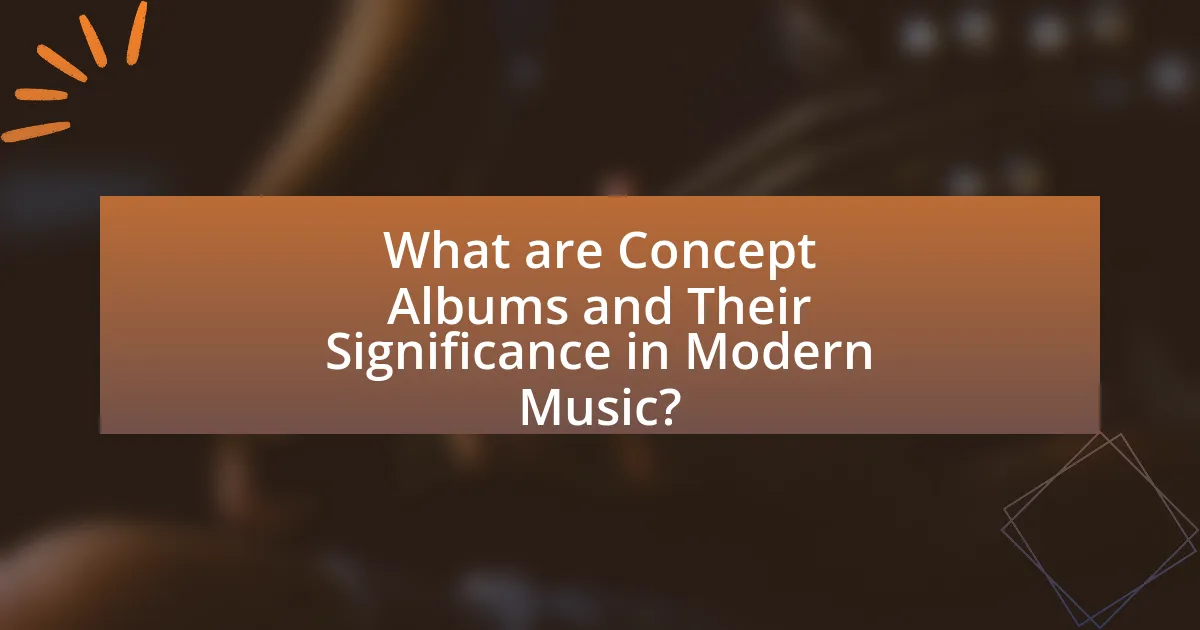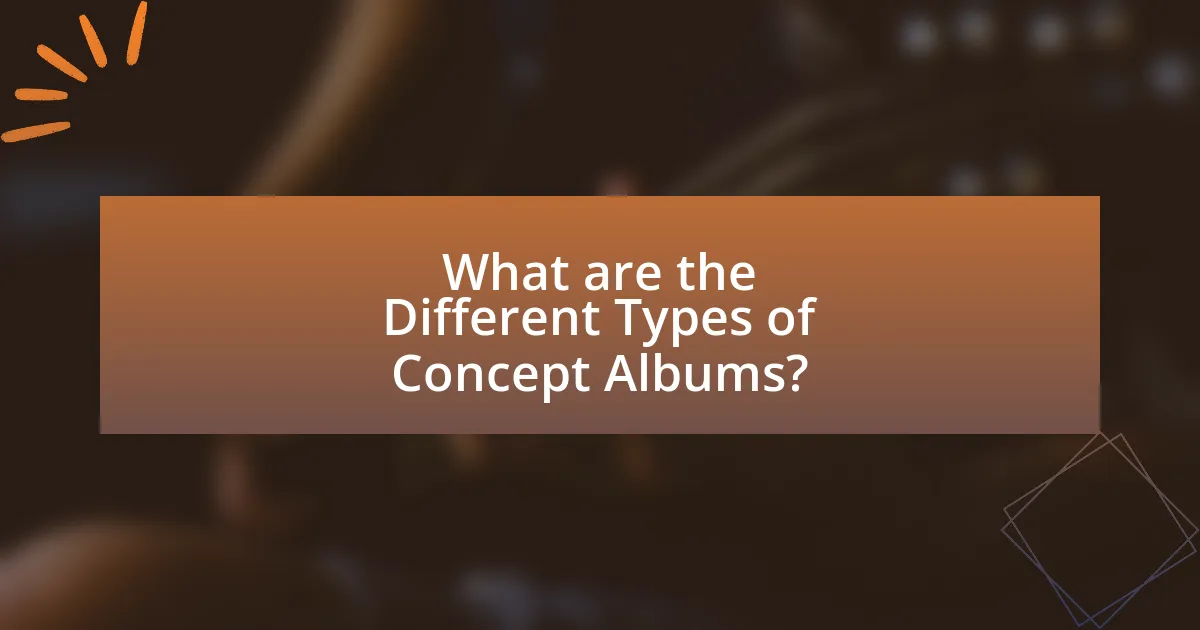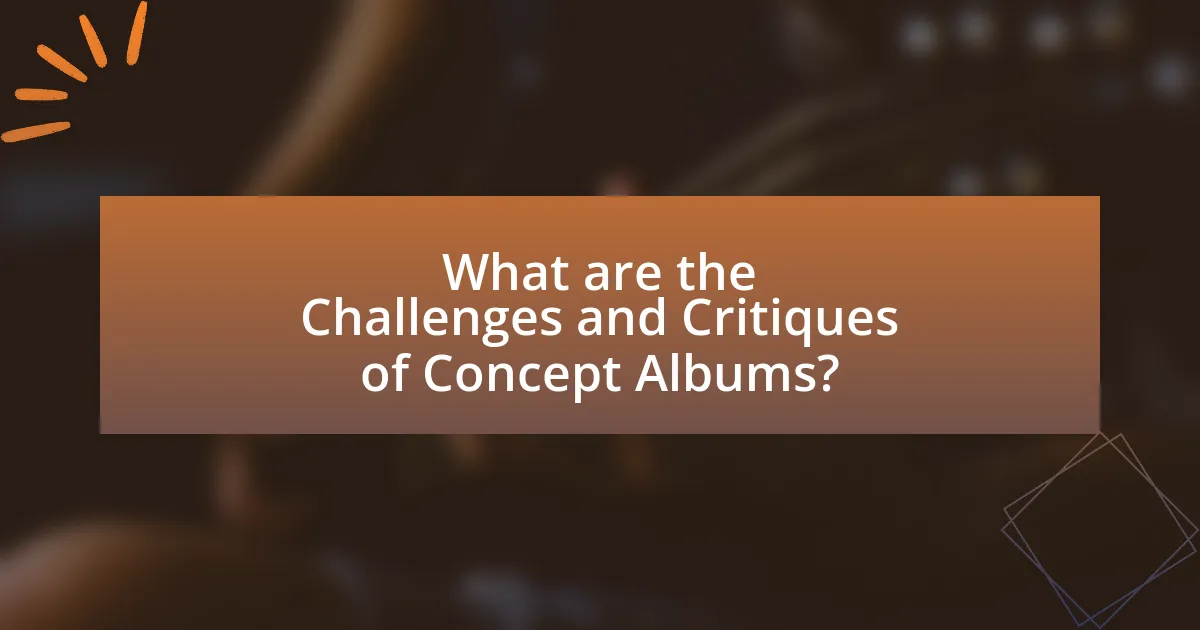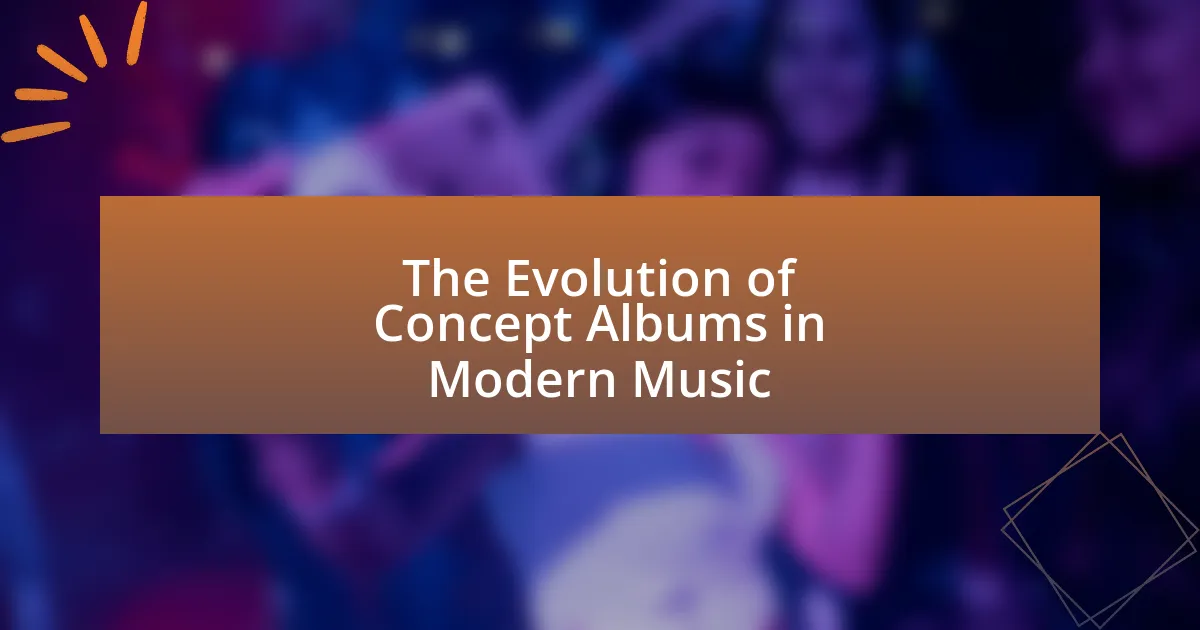The article explores the evolution of concept albums in modern music, defining them as cohesive works centered around a central theme or narrative. It discusses the origins of the concept album format in the 1960s, highlighting pioneering artists such as The Beatles and Pink Floyd, and examines the historical and cultural influences that contributed to their rise. The article also categorizes different types of concept albums, analyzes the significance of narrative and thematic elements, and addresses the challenges and critiques faced by artists in creating these works. Additionally, it considers the impact of streaming platforms on the production and popularity of concept albums, as well as best practices for artists aiming to balance artistic vision with commercial viability.

What are Concept Albums and Their Significance in Modern Music?
Concept albums are cohesive musical works that revolve around a central theme or narrative, often presenting a unified story or concept across multiple tracks. Their significance in modern music lies in their ability to enhance artistic expression and engage listeners on a deeper level, allowing for a more immersive experience. For instance, Pink Floyd’s “The Wall” and Kendrick Lamar’s “To Pimp a Butterfly” exemplify how concept albums can address complex themes such as personal struggle and social issues, respectively. This format encourages artists to explore intricate narratives and emotional depth, thereby influencing the evolution of music as a storytelling medium.
How did the concept album format originate?
The concept album format originated in the 1960s as artists sought to create cohesive musical narratives rather than just collections of individual songs. Pioneering albums like The Beatles’ “Sgt. Pepper’s Lonely Hearts Club Band” and The Beach Boys’ “Pet Sounds” exemplified this shift, where thematic continuity and artistic expression became central to the album experience. These albums integrated various musical styles and storytelling elements, influencing subsequent generations of musicians to explore deeper artistic concepts within their work.
What historical events influenced the rise of concept albums?
The rise of concept albums was significantly influenced by the cultural and technological shifts of the 1960s. The advent of rock music as a dominant genre, coupled with the counterculture movement, encouraged artists to explore deeper narratives and cohesive themes in their work. The Beatles’ “Sgt. Pepper’s Lonely Hearts Club Band,” released in 1967, is often cited as a pivotal example, showcasing the potential of albums as artistic statements rather than mere collections of songs. Additionally, advancements in recording technology allowed for more complex production techniques, enabling musicians to experiment with soundscapes and storytelling. These factors collectively contributed to the emergence and popularity of concept albums in modern music.
Who were the pioneering artists in the concept album genre?
The pioneering artists in the concept album genre include The Beatles, Pink Floyd, and The Who. The Beatles’ “Sgt. Pepper’s Lonely Hearts Club Band,” released in 1967, is often credited as one of the first true concept albums, as it presents a cohesive narrative and thematic structure. Pink Floyd further advanced the genre with “The Dark Side of the Moon” in 1973, which explores complex themes of mental health and societal issues, seamlessly blending music and storytelling. The Who’s “Tommy,” released in 1969, is another landmark concept album that tells the story of a deaf, dumb, and blind boy, showcasing the potential of rock music as a narrative medium. These artists laid the groundwork for future concept albums by integrating storytelling with musical composition.
What characteristics define a concept album?
A concept album is defined by its cohesive narrative or thematic structure that connects all the songs within it. This characteristic often involves a central storyline or concept that is explored throughout the album, allowing for a deeper artistic expression. For example, Pink Floyd’s “The Wall” presents a continuous narrative about isolation and personal struggle, illustrating how the songs interrelate to enhance the overall message. Additionally, concept albums frequently employ recurring musical motifs or lyrical themes, which further unify the work and create a more immersive listening experience. This approach has been a hallmark of various artists, demonstrating the evolution of storytelling in music.
How do narrative and thematic elements shape concept albums?
Narrative and thematic elements are essential in shaping concept albums by providing a cohesive storyline and emotional depth that guide the listener’s experience. These elements create a structured framework that connects individual tracks, allowing them to function as chapters within a larger narrative arc. For instance, Pink Floyd’s “The Wall” employs a narrative of isolation and psychological struggle, which enhances the thematic exploration of alienation and societal critique. This integration of narrative and theme not only enriches the artistic expression but also engages listeners on a deeper level, making the album more memorable and impactful.
What role does musical cohesion play in a concept album?
Musical cohesion in a concept album serves to unify the thematic and narrative elements, creating a seamless listening experience. This cohesion is achieved through consistent musical motifs, lyrical themes, and stylistic choices that reinforce the overarching story or concept. For instance, Pink Floyd’s “The Wall” exemplifies this by using recurring musical themes and lyrics that reflect the protagonist’s psychological journey, thereby enhancing the narrative’s emotional impact. Such cohesion not only engages listeners but also allows for deeper interpretation of the album’s message, as seen in works like The Who’s “Tommy,” where interconnected songs contribute to a singular narrative arc.
Why have concept albums gained popularity in recent years?
Concept albums have gained popularity in recent years due to the rise of streaming platforms that allow for immersive listening experiences. These platforms enable artists to present cohesive narratives and thematic explorations across multiple tracks, appealing to listeners seeking deeper engagement with music. Additionally, the cultural shift towards storytelling in various media, such as film and television, has influenced music consumption, making concept albums more attractive. The success of recent concept albums, like Kendrick Lamar’s “To Pimp a Butterfly,” which addresses complex social issues, further validates this trend by demonstrating the commercial viability and artistic merit of such projects.
What cultural shifts have contributed to the resurgence of concept albums?
The resurgence of concept albums has been significantly influenced by the rise of streaming services and the shift towards a more narrative-driven music experience. Streaming platforms like Spotify and Apple Music allow artists to present cohesive stories through their albums, encouraging listeners to engage with entire projects rather than individual singles. This cultural shift aligns with the increasing consumer preference for immersive storytelling, as seen in other media forms such as television and film, where serialized narratives have gained popularity. Additionally, the DIY ethos fostered by social media enables independent artists to create and promote concept albums without traditional industry constraints, further contributing to their revival.
How do streaming platforms impact the production of concept albums?
Streaming platforms significantly influence the production of concept albums by enabling artists to reach wider audiences and facilitating the integration of multimedia elements. These platforms allow musicians to release their work in a serialized format, which can enhance the storytelling aspect of concept albums, as seen in projects like “The Life of Pablo” by Kanye West, where tracks were updated post-release based on listener feedback. Additionally, data analytics from streaming services provide insights into listener preferences, guiding artists in their creative decisions and promoting more cohesive thematic elements within albums. This shift towards digital consumption has led to a decline in traditional album sales, prompting artists to adapt their production strategies to maintain engagement and relevance in a competitive market.

What are the Different Types of Concept Albums?
Concept albums can be categorized into several types based on their thematic and narrative structures. The primary types include narrative concept albums, which tell a story throughout the album, such as “The Wall” by Pink Floyd; thematic concept albums, which explore a specific theme or idea without a linear narrative, like “OK Computer” by Radiohead; and rock operas, which combine music and theatrical elements to convey a story, exemplified by “Tommy” by The Who. Each type serves to enhance the listening experience by providing a cohesive artistic vision, demonstrating the evolution of storytelling in modern music.
How do narrative-driven concept albums differ from thematic ones?
Narrative-driven concept albums differ from thematic ones primarily in their storytelling approach. Narrative-driven albums focus on a cohesive storyline that unfolds throughout the tracks, often featuring characters, plots, and a clear beginning, middle, and end, as seen in works like Pink Floyd’s “The Wall.” In contrast, thematic albums explore a central idea or concept without necessarily following a linear narrative, such as Radiohead’s “OK Computer,” which addresses themes of alienation and technology without a specific storyline. This distinction highlights how narrative-driven albums prioritize storytelling, while thematic albums emphasize broader concepts or emotions.
What are some examples of narrative-driven concept albums?
Some examples of narrative-driven concept albums include “The Wall” by Pink Floyd, which tells the story of a rock star’s descent into isolation and madness, and “American Idiot” by Green Day, which critiques American society and politics through the journey of a character named Jesus of Suburbia. Another notable example is “The Rise and Fall of Ziggy Stardust and the Spiders from Mars” by David Bowie, which follows the fictional rock star Ziggy Stardust and explores themes of fame and identity. These albums are recognized for their cohesive storytelling and thematic depth, making them significant in the evolution of concept albums in modern music.
How do thematic concept albums explore broader ideas?
Thematic concept albums explore broader ideas by weaving narratives and themes throughout their tracks, allowing artists to delve into complex subjects such as identity, society, and existentialism. For instance, Pink Floyd’s “The Wall” addresses themes of isolation and mental health, using a cohesive storyline to illustrate the protagonist’s struggles. This approach enables listeners to engage with the material on a deeper level, as the interconnected songs create a holistic experience that reflects real-world issues. Additionally, artists like Kendrick Lamar in “To Pimp a Butterfly” use their albums to comment on race, culture, and personal growth, effectively transforming personal narratives into universal discussions. Such albums not only entertain but also provoke thought and dialogue about significant societal themes.
What role do collaborations play in concept albums?
Collaborations play a crucial role in concept albums by enhancing thematic depth and musical diversity. They allow artists to combine different styles, perspectives, and creative inputs, resulting in a richer narrative and sound. For instance, the collaboration between David Bowie and Brian Eno on the “Berlin Trilogy” introduced innovative production techniques and genre-blending that significantly shaped the albums’ conceptual frameworks. This synergy not only broadens the artistic scope but also attracts a wider audience, as seen in projects like “The Life of Pablo” by Kanye West, which features multiple artists contributing to a cohesive narrative. Such collaborations are essential for pushing creative boundaries and achieving a more complex artistic vision in concept albums.
How do collaborative concept albums enhance the storytelling experience?
Collaborative concept albums enhance the storytelling experience by integrating diverse artistic perspectives, which enriches the narrative depth. When multiple artists contribute to a single project, they bring unique styles, themes, and emotional nuances that create a multifaceted story. For example, the album “The Life of Pablo” by Kanye West features contributions from various artists, allowing for a complex exploration of themes such as identity and redemption. This collaborative approach not only broadens the narrative scope but also fosters a more immersive experience for listeners, as they engage with a tapestry of voices and viewpoints that reflect a wider range of human experiences.
What notable collaborations have resulted in successful concept albums?
Notable collaborations that have resulted in successful concept albums include “The Wall” by Pink Floyd, which explores themes of isolation and mental health, and “American Idiot” by Green Day, a punk rock opera addressing political disillusionment. Another significant collaboration is “The Life of Pablo” by Kanye West, which blends various musical styles and narratives about fame and personal struggles. These albums achieved critical acclaim and commercial success, with “The Wall” selling over 30 million copies worldwide and “American Idiot” winning the Grammy Award for Best Musical Show Album.

What are the Challenges and Critiques of Concept Albums?
Concept albums face several challenges and critiques, primarily related to coherence, accessibility, and commercial viability. The complexity of weaving a narrative throughout an album can lead to a lack of cohesion, making it difficult for listeners to engage with the music as a standalone experience. Critics often argue that the ambitious storytelling can overshadow musical quality, resulting in albums that prioritize concept over composition. Additionally, concept albums may alienate casual listeners who prefer individual tracks rather than a continuous narrative, limiting their mainstream appeal. The commercial success of concept albums can also be hindered, as they often require more investment in marketing and promotion to convey their artistic vision effectively. Historical examples, such as Pink Floyd’s “The Wall,” illustrate both the artistic triumphs and the potential pitfalls of concept albums, highlighting the balance between creativity and audience reception.
What common criticisms do concept albums face?
Concept albums commonly face criticisms for being overly ambitious, leading to incoherent narratives that can confuse listeners. Critics argue that the complexity of the storyline often detracts from the music itself, making it less accessible. Additionally, some concept albums are criticized for prioritizing thematic elements over musical quality, resulting in tracks that may feel disjointed or lack individual appeal. This criticism is supported by reviews of various concept albums, where listeners express frustration over the perceived lack of memorable songs compared to traditional albums.
How do critics argue that concept albums can be limiting?
Critics argue that concept albums can be limiting because they often prioritize a cohesive narrative over individual song quality. This focus on storytelling can restrict artistic expression, leading to tracks that serve the overarching theme rather than standing out on their own. For example, some critics point to albums like “The Wall” by Pink Floyd, where the narrative structure may overshadow musical innovation, resulting in songs that feel less impactful when isolated from the album’s context. Additionally, this narrative constraint can alienate listeners who prefer diverse musical styles or themes, as the album’s coherence may come at the expense of variety.
What are the challenges artists encounter when creating concept albums?
Artists encounter several challenges when creating concept albums, primarily related to narrative coherence, musical cohesion, and audience reception. Maintaining a consistent storyline throughout the album can be difficult, as artists must ensure that each track contributes to the overarching theme without losing individual song quality. Additionally, achieving a seamless musical flow that aligns with the narrative can complicate the songwriting process, requiring careful arrangement and production choices.
Moreover, artists face the challenge of audience engagement; concept albums may not appeal to all listeners, as some may prefer standalone tracks over a cohesive narrative experience. This can impact commercial success and radio play, as seen with albums like Pink Floyd’s “The Wall,” which, despite its critical acclaim, faced challenges in mainstream acceptance due to its complex themes. Thus, the interplay of narrative, musicality, and audience expectations presents significant hurdles for artists in the realm of concept albums.
How can artists overcome the challenges of producing a concept album?
Artists can overcome the challenges of producing a concept album by establishing a clear narrative structure and thematic coherence from the outset. This approach allows artists to create a cohesive listening experience that engages the audience throughout the album. For instance, successful concept albums like Pink Floyd’s “The Wall” and The Who’s “Tommy” demonstrate how a well-defined storyline can enhance the emotional impact and listener connection. Additionally, artists can utilize collaborative efforts with producers and other musicians to refine their vision and ensure that each track contributes meaningfully to the overall concept. This collaborative process has been shown to improve the quality and depth of the final product, as seen in the work of contemporary artists like Kendrick Lamar in “To Pimp a Butterfly,” where diverse influences and perspectives enrich the narrative.
What strategies can artists employ to maintain listener engagement?
Artists can maintain listener engagement by incorporating storytelling elements into their music, creating immersive experiences that resonate with audiences. This strategy involves crafting a cohesive narrative throughout an album, which encourages listeners to engage more deeply with the material. For example, Pink Floyd’s “The Wall” utilizes a continuous storyline that captivates listeners, making them more invested in the music. Additionally, artists can leverage multimedia elements, such as visual art or interactive content, to enhance the listening experience. Research indicates that albums with strong thematic coherence and accompanying visuals can increase listener retention and emotional connection, as seen in works by artists like Beyoncé in “Lemonade.” These strategies effectively foster a deeper relationship between the artist and the audience, ensuring sustained engagement.
How can artists balance artistic vision with commercial viability?
Artists can balance artistic vision with commercial viability by integrating their unique creative expressions with market trends and audience preferences. This approach involves conducting market research to understand listener demographics and preferences while maintaining the core elements of their artistic identity. For instance, successful artists often analyze streaming data and social media engagement to identify popular themes or sounds that resonate with audiences, allowing them to craft concept albums that reflect both their vision and commercial appeal. A notable example is the album “To Pimp a Butterfly” by Kendrick Lamar, which combines deep personal and societal themes with elements that garnered widespread commercial success, demonstrating that a thoughtful blend of artistry and market awareness can lead to both critical acclaim and financial viability.
What are some best practices for creating a successful concept album?
To create a successful concept album, artists should focus on a cohesive narrative that connects each track, ensuring thematic consistency throughout the project. This involves developing a clear storyline or concept that resonates with listeners, as seen in albums like Pink Floyd’s “The Wall,” which explores themes of isolation and mental health. Additionally, artists should consider the arrangement of songs to enhance the narrative flow, using transitions and interludes effectively to maintain engagement. Incorporating diverse musical styles while staying true to the overarching theme can also enrich the listening experience, as demonstrated by The Beatles in “Sgt. Pepper’s Lonely Hearts Club Band.” Finally, engaging visual elements, such as album art and music videos, can further reinforce the concept and attract a wider audience.
How can artists effectively develop a cohesive narrative throughout the album?
Artists can effectively develop a cohesive narrative throughout an album by establishing a central theme or storyline that connects each track. This approach allows for a seamless flow of ideas and emotions, creating a unified listening experience. For instance, Pink Floyd’s “The Wall” exemplifies this technique, as it tells a continuous story of isolation and personal struggle, with each song contributing to the overarching narrative. Additionally, artists can use recurring motifs, lyrical callbacks, and consistent musical styles to reinforce the narrative, as seen in Kendrick Lamar’s “good kid, m.A.A.d city,” where the tracks collectively depict a journey through his upbringing in Compton. By carefully structuring the album around these elements, artists can ensure that listeners engage with the narrative as a whole rather than as isolated songs.
What role does audience feedback play in the concept album creation process?
Audience feedback plays a crucial role in the concept album creation process by influencing the artistic direction and thematic development of the work. Artists often use feedback from live performances, social media interactions, and pre-release listening sessions to gauge audience reactions, which can lead to adjustments in lyrics, instrumentation, and overall narrative structure. For instance, the band Radiohead incorporated fan feedback during the creation of their album “Kid A,” which helped shape its experimental sound and lyrical themes. This iterative process not only enhances the emotional connection between the artist and the audience but also ensures that the final product resonates with listeners, ultimately impacting its commercial success and critical reception.
